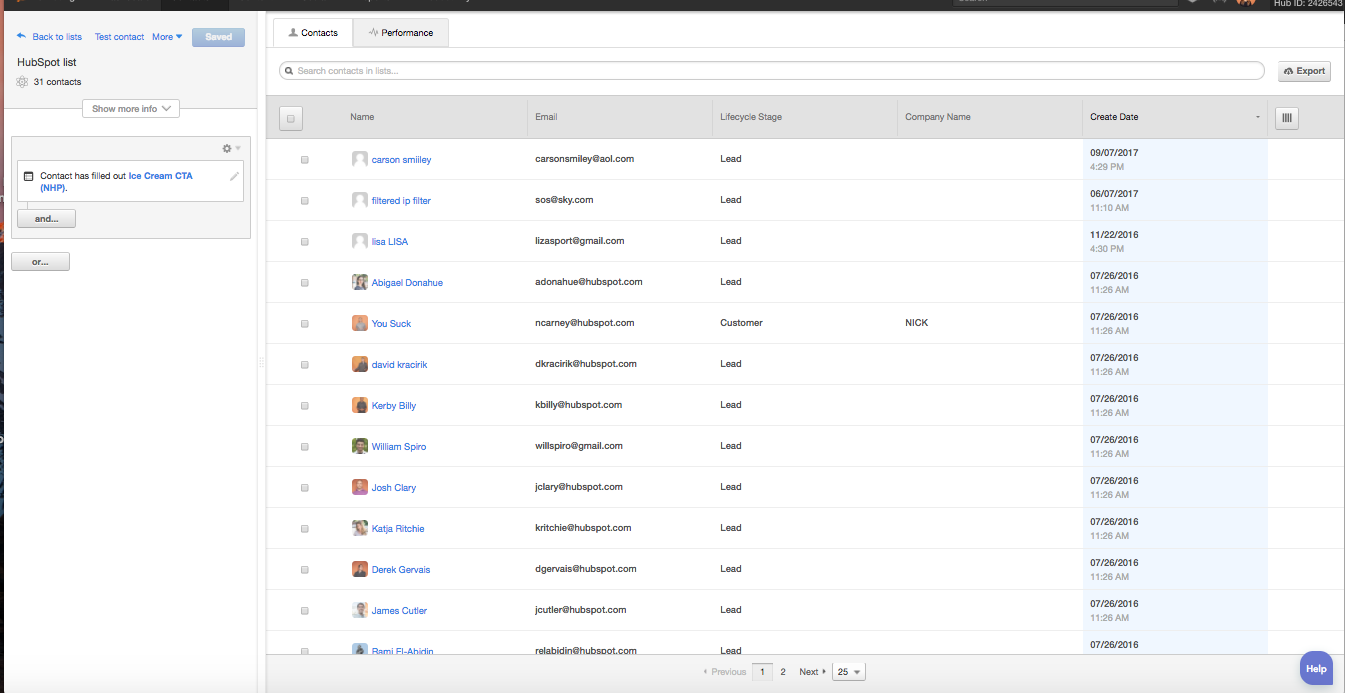![]() Attracting, converting, closing, and delighting your customers is important, but how do you know if you're doing it successfully?
Attracting, converting, closing, and delighting your customers is important, but how do you know if you're doing it successfully?

Marketers and salespeople can use reports to measure the success of their efforts and identify what's working well and what needs attention.
But with so many different ways to report on information, it can be difficult to choose how to convey results in the most digestible way.
When you're asked to assess or evaluate your team's marketing and sales efforts, the word “report” might come to mind. But, in many instances, a list or a saved filter could be a better choice to represent that data.
In this post, we'll walk through when to use a report or a list to display data.
Option One: Using Lists and Saved Filters in HubSpot
Both lists and saved filters help you segment objects like contacts, deals, or companies based on specific criteria.
Marketing Basic, Professional, and Enterprise users have access to lists. In addition to creating static lists, you can also use smart lists. Smart lists are dynamic. This means they automatically update. New contacts who meet the criteria will join the list even after the list has been created for the first time.
Smart lists can be extremely useful for reporting purposes. For example, you can keep track of the current number of contacts to date who opened an email. Additionally, you can use columns to show properties associated with those contacts, such as email, lifecycle stage, create date, and company.
Learn how to create a smart list.

For those who are not Marketing Basic, Professional or Enterprise users, there are saved filters. Saved filters are available to all HubSpot CRM and HubSpot Marketing users.
Much like lists, saved filters help you quickly view a segment of your contacts or companies from your database. You can use any default or custom property in your HubSpot account to segment your contacts using saved filters.
Saved filters also resemble lists in that contacts will be added or removed from saved filters automatically based on whether or not they currently meet the criteria you've set.
Learn how to create a saved filter.
Option Two: Using Reports in HubSpot
Your dashboard helps you create and manage reports in HubSpot.
Marketing Free, Basic, Professional, and Enterprise users have access to the marketing dashboard. Sales Free, Starter, and Professional accounts have access to the sales dashboard. For further customization of your reports, you can purchase the reporting add-on. The reporting add-on helps users create their own reports and further customize HubSpot’s default reports.
Your reports home in HubSpot is a collection of all of your reports organized in a dashboard format. This collection of different reports helps you monitor your company's progress in one place. Both sales and marketing users have access to an entire library of dozens of out-of-the-box reports that can be added to any of your HubSpot dashboards with one click. These reports range from a blog performance report to a sales activity report.
The Decision: When to Use a List Instead of a Report
Now that you have a better understanding of the differences between lists and reports in HubSpot, let’s take a look at when to use one over another.
Goal: To see a group of objects that fit specific criteria and display additional details of each object.
Report or list? Use a saved filter or a list.
Columns are easily customizable to show additional information or details about an object. For instance, if you want to see all contacts who filled out a specific form as well as their associated email addresses, employers, and job titles, you could create a list to accomplish this goal. The list would be filtered: contact filled out x form. From here, you could customize the columns to show email addresses, employers, and job titles.
Goal: To present a large group of records.
Report or list? Lists and saved filters, because don't have a limit to the amount of objects they display. They're also a more visibly pleasing way to view this data than a bar graph or a line graph. An example would be if you want to see 200 contacts and their associated country.
Goal: To compare data.
Report or list? While lists are beneficial when looking at details of objects or a large group, they cannot show a comparison or a change over a period of time. However, reports give you the ability to show change or differences. If you're a manager and you want to compare the number of calls each sales rep makes, a bar graph would be favorable. A bar graph allows you to quickly understand which of your sales reps is going the extra mile — and which need a little extra push.
Goal: To display data in a visual format.
Report or list? Reports are also advantageous in this case. Sometimes, visual representation can be more useful and give you a snapshot of your marketing and sales efforts. For instance, a line graph is perfect if you want to see how your blog has performed over time. With one quick glance, you can determine if you have consistent success or a time period that was less successful.
Considering the right data path.
Often, when we hear words like "data," "measure," and "analyze," we automatically navigate to the dashboard and look for a report.
While reports are beneficial for displaying certain types of data, they shouldn't be considered defaults. It's important to think about the data you're analyzing and the best way to display it. Lists and saved filters are a great example of the duality features you can use in HubSpot.






![3 Service-focused Workflows to Empower Your Support Team [Support Series]](https://53.fs1.hubspotusercontent-na1.net/hubfs/53/service%20button.jpeg)
![How to Add Your Branding to a Marketplace Template [Support Series]](https://53.fs1.hubspotusercontent-na1.net/hubfs/53/Support/Support%20Series%20User%20Blog%20folder%20copy%202.png)
![Creating a Custom Date-Based Property Report [Support Series]](https://53.fs1.hubspotusercontent-na1.net/hubfs/53/Support/HubSpot%20Support%20Series%20Horizontal-603978-edited.png)